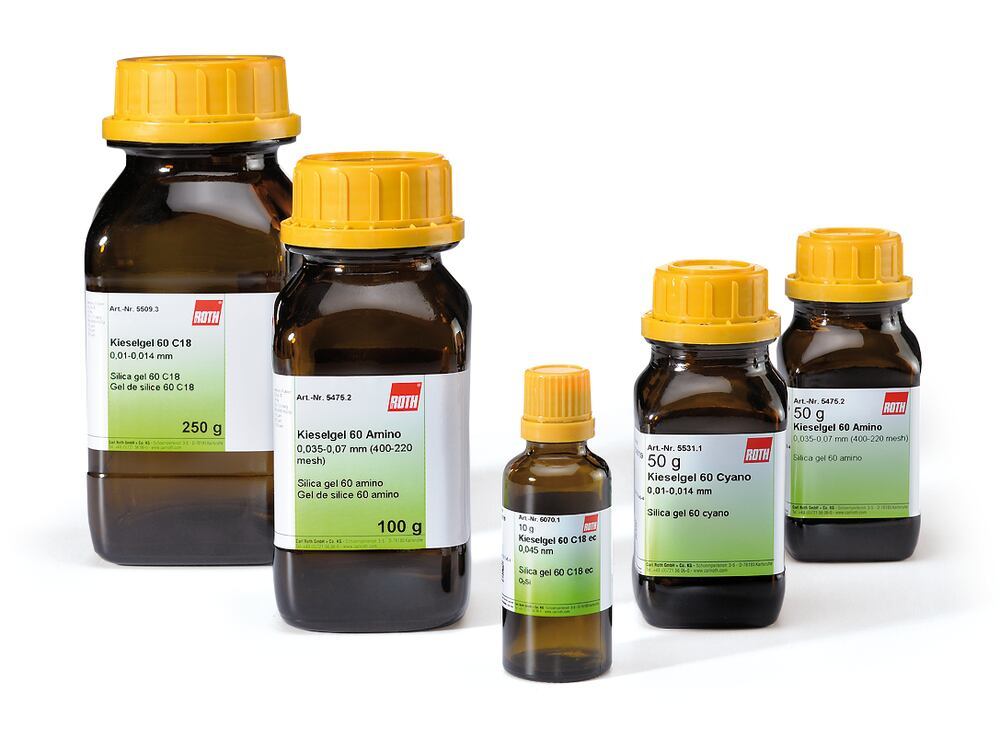Technical Data Sheet
Silica gel 60 C18 ec, 25 g
Molar mass (M) 60,09 g/mol
Density (D) 2,2 g/cm³
Melting point (mp) 1713 °C
CAS No. 7631-86-9
EG-Nr. 231-545-4
€177.40/Pack Qty.
excl. VAT. | 25 g per Pack Qty.
Art. No. 6070.2
Product details
Silica gel 60 C18 ec 0,02-0,05 mm
| Particle size | 0,02-0,05 mm |
- Subtotal: 0.00
| Art. No. | Pack Qty. | Pack. | Price | Quantity | |
|---|---|---|---|---|---|
| 6070.1 | 10 g | glass |
€91.95 |
|
|
| 6070.2 | 25 g | glass |
€177.40 |
|
|
|
In stock
Available
In procurement
No longer available
Delivery date currently unknown
|
|||||
- Subtotal: 0.00
Downloads / MSDS
General information
Further attractive products to complete your chromatography laboratory can be found on our Chromatography page!
Silica gels are the most important sorbents in the purification and separation processes used in column chromatography. Our extensive range of silica gels with various different pore and particle sizes means that we always have the right material for any separation procedure. In addition to standard 60 Å silica gel, our range includes silica gels with pore sizes between 150 Å and 4500 Å, as well 22 Å and 35 Å for separating particularly small molecules. A selection of modified silica gel 60 grades completes the range.
Advantages:
- Extensive range
- Stringent quality control of the starting materials and the end products
- High purity; optimised to meet the needs of chromatography applications
- Large surface area for a high load-bearing capacity
- Tight particle size distribution for optimal efficiency and low pressure variations
For pesticide residue analysis in food
The QuEChERS (Quick, Easy, Cheap, Efficient, Rugged, Safe; "Catchers") method has achieved a leading position for the determination of pesticide residues in food by GC-MS or LC-MS within a few years of its development.
This method was developed using an extraction method for pesticides in fruit and vegetables coupled with a clean-up method that removes sugars, lipids, organic acids, sterols, proteins, pigments and excess water. This technique offers a user-friendly alternative to conventional liquid-liquid and solid phase extractions.
The process involves two simple steps. First, an extraction of the homogenised samples takes place, which are split with an organic solvent and a salt solution. The supernatant is then further extracted and purified using dispersive solid phase extraction (dSPE).
This allows rapid and cost-effective processing of heavily matrix-loaded samples. In order to optimise the extraction of pH-dependent compounds, to minimise the decomposition of sensitive substances and to cover a broad matrix spectrum, various modifications of the QuEChERS method have been developed.
- Unbuffered original method
- European method EN 15662
- AOAC Official 2007.01 Method
Carl ROTH offers QuEChERS extraction and dSPE products in a variety of standard sizes and formats, making the QuEChERS method even easier to use.
Extraction
The choice between the original unbuffered method salts and buffered method salts should be based on the expected pH of the final extract and the pH sensitivity of the target analytes. The unbuffered original method is well suited for most analytes. When using unbuffered salts, the pH of the final extract is largely determined by the pH of the sample. However, if critical target analytes are unstable at certain pH values, a buffered method that maintains the required pH will provide more accurate results for pH-sensitive pesticides.
For extraction, the European Standard EN 15662 recommends a citrate extraction mix, while the AOAC Standard 2007.1 uses an acetate extraction mix.
Clean up via dSPE
The key to optimising QuEChERS purification lies in the selection of absorbents that effectively remove different types of interferences in different samples. The aim is to achieve efficient but not excessive purification so that interferences are removed and the target analytes remain in the extract.
During purification, the diamino phase (PSA) removes sugars and organic acids, for example. Magnesium sulphate is used to remove water, while C18 ec removes non-polar interfering substances such as fats and the carbon phase removes pigments, sterols and other non-polar substances.
The type and relative amount of matrix components that need to be removed from the extracts prior to analysis will help you select the appropriate dSPE products.
Adsorbents and what their use
| MgSO4 | Removes excess of water |
| NaCl | For phase separation |
| Silica Gel 60 Diamino (PSA) (Primary Secondary Amine) |
Removes organic and fatty acids, sugars and polar pigments (e.g. anthocyanes) |
| Silica Gel 60 C18 ec (reversed phase modified silica) |
Traps nonpolar compounds (e.g. lipids) |
| Carbon (GCB) (Activated Charcoal / Graphitized Carbon Black) |
Removes non polar pigments and sterols (please note: planar pesticides are also removed) |
Certificates of Analysis
Type analysis
| Pore diameter | 55-75 Å |
| Particle size | 20-50 µm |
| Capacity (mg caffein/g sorbent) | ≥90 |
| Loss on ignition | 17-23 % |





